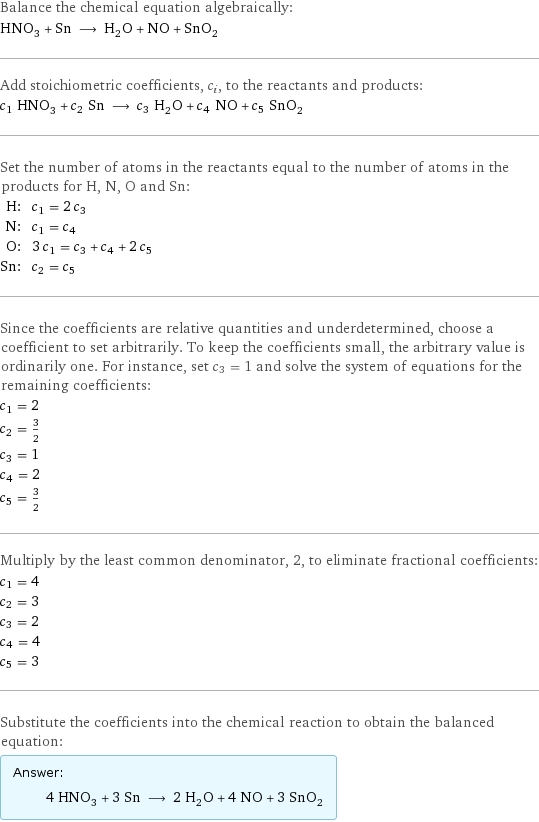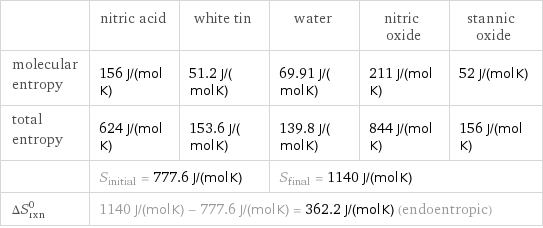Input interpretation

HNO_3 nitric acid + Sn white tin ⟶ H_2O water + NO nitric oxide + SnO_2 stannic oxide
Balanced equation

Balance the chemical equation algebraically: HNO_3 + Sn ⟶ H_2O + NO + SnO_2 Add stoichiometric coefficients, c_i, to the reactants and products: c_1 HNO_3 + c_2 Sn ⟶ c_3 H_2O + c_4 NO + c_5 SnO_2 Set the number of atoms in the reactants equal to the number of atoms in the products for H, N, O and Sn: H: | c_1 = 2 c_3 N: | c_1 = c_4 O: | 3 c_1 = c_3 + c_4 + 2 c_5 Sn: | c_2 = c_5 Since the coefficients are relative quantities and underdetermined, choose a coefficient to set arbitrarily. To keep the coefficients small, the arbitrary value is ordinarily one. For instance, set c_3 = 1 and solve the system of equations for the remaining coefficients: c_1 = 2 c_2 = 3/2 c_3 = 1 c_4 = 2 c_5 = 3/2 Multiply by the least common denominator, 2, to eliminate fractional coefficients: c_1 = 4 c_2 = 3 c_3 = 2 c_4 = 4 c_5 = 3 Substitute the coefficients into the chemical reaction to obtain the balanced equation: Answer: | | 4 HNO_3 + 3 Sn ⟶ 2 H_2O + 4 NO + 3 SnO_2
Structures

+ ⟶ + +
Names

nitric acid + white tin ⟶ water + nitric oxide + stannic oxide
Reaction thermodynamics
Entropy

| nitric acid | white tin | water | nitric oxide | stannic oxide molecular entropy | 156 J/(mol K) | 51.2 J/(mol K) | 69.91 J/(mol K) | 211 J/(mol K) | 52 J/(mol K) total entropy | 624 J/(mol K) | 153.6 J/(mol K) | 139.8 J/(mol K) | 844 J/(mol K) | 156 J/(mol K) | S_initial = 777.6 J/(mol K) | | S_final = 1140 J/(mol K) | | ΔS_rxn^0 | 1140 J/(mol K) - 777.6 J/(mol K) = 362.2 J/(mol K) (endoentropic) | | | |
Equilibrium constant
![Construct the equilibrium constant, K, expression for: HNO_3 + Sn ⟶ H_2O + NO + SnO_2 Plan: • Balance the chemical equation. • Determine the stoichiometric numbers. • Assemble the activity expression for each chemical species. • Use the activity expressions to build the equilibrium constant expression. Write the balanced chemical equation: 4 HNO_3 + 3 Sn ⟶ 2 H_2O + 4 NO + 3 SnO_2 Assign stoichiometric numbers, ν_i, using the stoichiometric coefficients, c_i, from the balanced chemical equation in the following manner: ν_i = -c_i for reactants and ν_i = c_i for products: chemical species | c_i | ν_i HNO_3 | 4 | -4 Sn | 3 | -3 H_2O | 2 | 2 NO | 4 | 4 SnO_2 | 3 | 3 Assemble the activity expressions accounting for the state of matter and ν_i: chemical species | c_i | ν_i | activity expression HNO_3 | 4 | -4 | ([HNO3])^(-4) Sn | 3 | -3 | ([Sn])^(-3) H_2O | 2 | 2 | ([H2O])^2 NO | 4 | 4 | ([NO])^4 SnO_2 | 3 | 3 | ([SnO2])^3 The equilibrium constant symbol in the concentration basis is: K_c Mulitply the activity expressions to arrive at the K_c expression: Answer: | | K_c = ([HNO3])^(-4) ([Sn])^(-3) ([H2O])^2 ([NO])^4 ([SnO2])^3 = (([H2O])^2 ([NO])^4 ([SnO2])^3)/(([HNO3])^4 ([Sn])^3)](../image_source/cac2b7e39c2ef6264bf9098e1063ee26.png)
Construct the equilibrium constant, K, expression for: HNO_3 + Sn ⟶ H_2O + NO + SnO_2 Plan: • Balance the chemical equation. • Determine the stoichiometric numbers. • Assemble the activity expression for each chemical species. • Use the activity expressions to build the equilibrium constant expression. Write the balanced chemical equation: 4 HNO_3 + 3 Sn ⟶ 2 H_2O + 4 NO + 3 SnO_2 Assign stoichiometric numbers, ν_i, using the stoichiometric coefficients, c_i, from the balanced chemical equation in the following manner: ν_i = -c_i for reactants and ν_i = c_i for products: chemical species | c_i | ν_i HNO_3 | 4 | -4 Sn | 3 | -3 H_2O | 2 | 2 NO | 4 | 4 SnO_2 | 3 | 3 Assemble the activity expressions accounting for the state of matter and ν_i: chemical species | c_i | ν_i | activity expression HNO_3 | 4 | -4 | ([HNO3])^(-4) Sn | 3 | -3 | ([Sn])^(-3) H_2O | 2 | 2 | ([H2O])^2 NO | 4 | 4 | ([NO])^4 SnO_2 | 3 | 3 | ([SnO2])^3 The equilibrium constant symbol in the concentration basis is: K_c Mulitply the activity expressions to arrive at the K_c expression: Answer: | | K_c = ([HNO3])^(-4) ([Sn])^(-3) ([H2O])^2 ([NO])^4 ([SnO2])^3 = (([H2O])^2 ([NO])^4 ([SnO2])^3)/(([HNO3])^4 ([Sn])^3)
Rate of reaction
![Construct the rate of reaction expression for: HNO_3 + Sn ⟶ H_2O + NO + SnO_2 Plan: • Balance the chemical equation. • Determine the stoichiometric numbers. • Assemble the rate term for each chemical species. • Write the rate of reaction expression. Write the balanced chemical equation: 4 HNO_3 + 3 Sn ⟶ 2 H_2O + 4 NO + 3 SnO_2 Assign stoichiometric numbers, ν_i, using the stoichiometric coefficients, c_i, from the balanced chemical equation in the following manner: ν_i = -c_i for reactants and ν_i = c_i for products: chemical species | c_i | ν_i HNO_3 | 4 | -4 Sn | 3 | -3 H_2O | 2 | 2 NO | 4 | 4 SnO_2 | 3 | 3 The rate term for each chemical species, B_i, is 1/ν_i(Δ[B_i])/(Δt) where [B_i] is the amount concentration and t is time: chemical species | c_i | ν_i | rate term HNO_3 | 4 | -4 | -1/4 (Δ[HNO3])/(Δt) Sn | 3 | -3 | -1/3 (Δ[Sn])/(Δt) H_2O | 2 | 2 | 1/2 (Δ[H2O])/(Δt) NO | 4 | 4 | 1/4 (Δ[NO])/(Δt) SnO_2 | 3 | 3 | 1/3 (Δ[SnO2])/(Δt) (for infinitesimal rate of change, replace Δ with d) Set the rate terms equal to each other to arrive at the rate expression: Answer: | | rate = -1/4 (Δ[HNO3])/(Δt) = -1/3 (Δ[Sn])/(Δt) = 1/2 (Δ[H2O])/(Δt) = 1/4 (Δ[NO])/(Δt) = 1/3 (Δ[SnO2])/(Δt) (assuming constant volume and no accumulation of intermediates or side products)](../image_source/717f63bfacfde2c78c0f08af054bde4d.png)
Construct the rate of reaction expression for: HNO_3 + Sn ⟶ H_2O + NO + SnO_2 Plan: • Balance the chemical equation. • Determine the stoichiometric numbers. • Assemble the rate term for each chemical species. • Write the rate of reaction expression. Write the balanced chemical equation: 4 HNO_3 + 3 Sn ⟶ 2 H_2O + 4 NO + 3 SnO_2 Assign stoichiometric numbers, ν_i, using the stoichiometric coefficients, c_i, from the balanced chemical equation in the following manner: ν_i = -c_i for reactants and ν_i = c_i for products: chemical species | c_i | ν_i HNO_3 | 4 | -4 Sn | 3 | -3 H_2O | 2 | 2 NO | 4 | 4 SnO_2 | 3 | 3 The rate term for each chemical species, B_i, is 1/ν_i(Δ[B_i])/(Δt) where [B_i] is the amount concentration and t is time: chemical species | c_i | ν_i | rate term HNO_3 | 4 | -4 | -1/4 (Δ[HNO3])/(Δt) Sn | 3 | -3 | -1/3 (Δ[Sn])/(Δt) H_2O | 2 | 2 | 1/2 (Δ[H2O])/(Δt) NO | 4 | 4 | 1/4 (Δ[NO])/(Δt) SnO_2 | 3 | 3 | 1/3 (Δ[SnO2])/(Δt) (for infinitesimal rate of change, replace Δ with d) Set the rate terms equal to each other to arrive at the rate expression: Answer: | | rate = -1/4 (Δ[HNO3])/(Δt) = -1/3 (Δ[Sn])/(Δt) = 1/2 (Δ[H2O])/(Δt) = 1/4 (Δ[NO])/(Δt) = 1/3 (Δ[SnO2])/(Δt) (assuming constant volume and no accumulation of intermediates or side products)
Chemical names and formulas

| nitric acid | white tin | water | nitric oxide | stannic oxide formula | HNO_3 | Sn | H_2O | NO | SnO_2 Hill formula | HNO_3 | Sn | H_2O | NO | O_2Sn name | nitric acid | white tin | water | nitric oxide | stannic oxide IUPAC name | nitric acid | tin | water | nitric oxide |